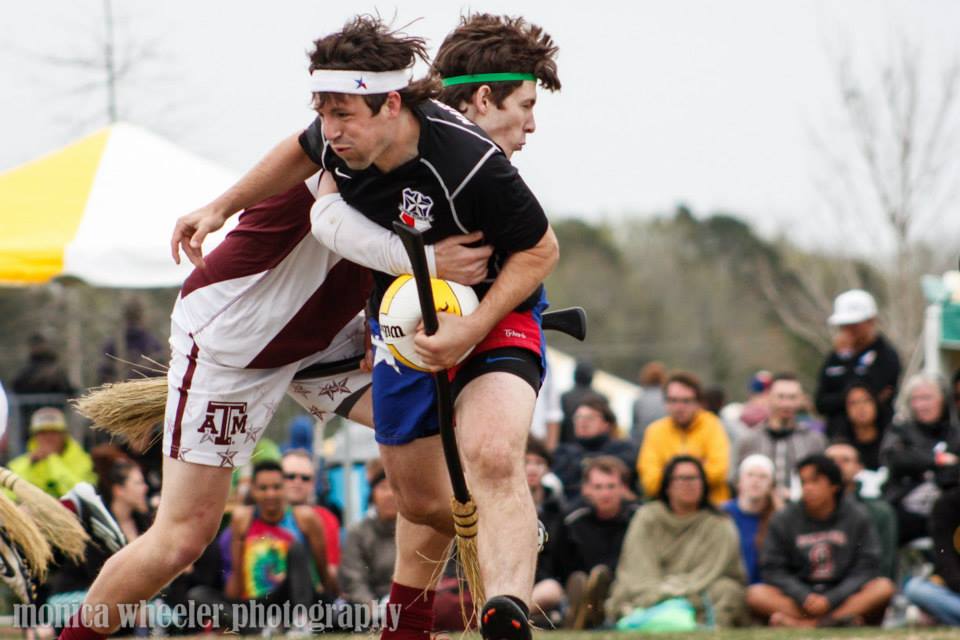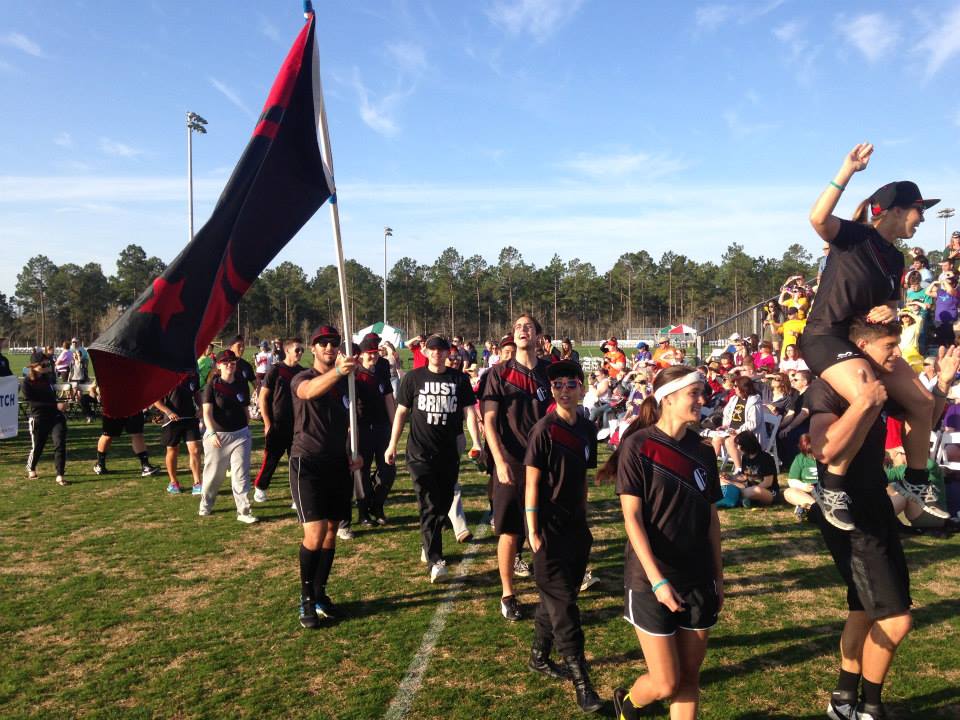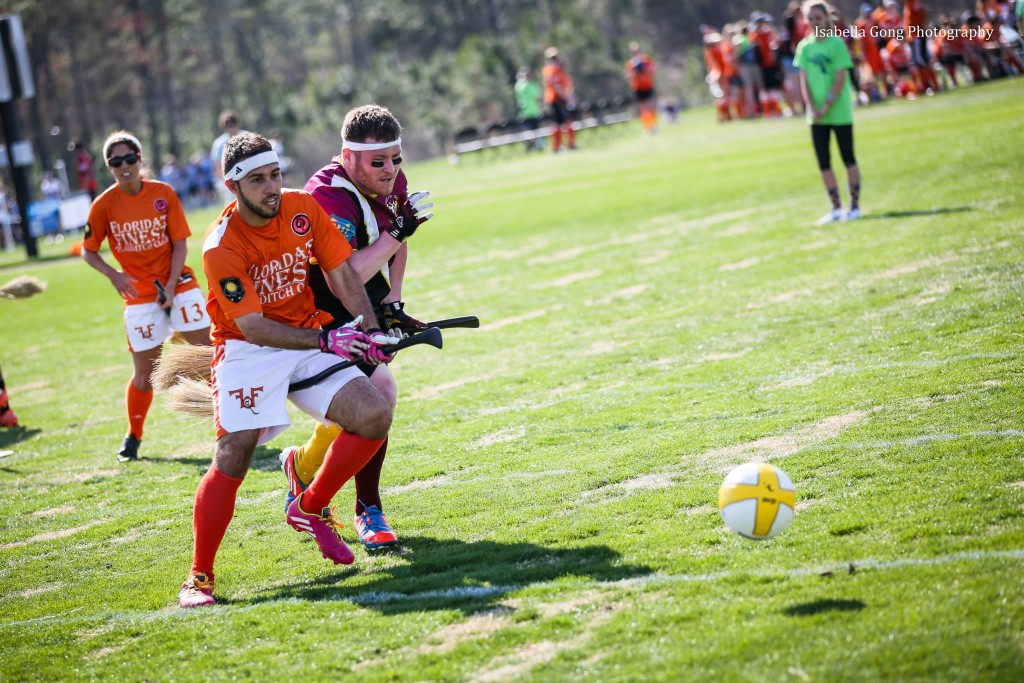- Rule, Britannia, no more?
- Unpopular Opinions: US Quadball Cup 2023
- Proven Contenders: University of Virginia
- Proven Contenders: Rutgers University
- Proven Contenders: University of Michigan
- Proven Contenders: Creighton University
- Different Perspectives: A Look Inside USA Ultimate
- Antwerp QC, Much of Belgian Core, Leaves Competitive Quidditch
The Plight of the Community Team
- Updated: May 12, 2014
“What is your ideal World Cup final?”
It was a question I got a lot over the course of the season, and for me, it was always the same answer. I wanted a championship game that pitted Lone Star QC against the Lost Boys, setting in motion the end of a combined league of community teams and the college squads that could no longer keep up with that, and prompting the formation of a “semi-pro” league of the best of the best.
It’s safe to say that I didn’t quite get what I wanted in North Myrtle Beach. Lone Star was the final community team standing, but only made it as far as the quarterfinals, falling 100*-70 to Texas A&M, the one hump they could never get over all season.
But Lone Star going out in the quarterfinals barely scratches the surface of community team disappointment. The NYDC Capitalists entered the Pool of Death as the Pot One team, but left it 2-2, falling short of bracket play. QC Boston Massacre, blessed with a joke of a pool, still managed just a 1-3 weekend, falling to Stanford and regional rival RIT.
And then there was the biggest surprise of the weekend. The Lost Boys took care of business on Saturday, but were one-and-done on Sunday, dropping out to LSU in the Round of 32. A disappointing performance all around, the Los Angeles-based side were matched in the beater game and had no answer for Brad Armentor in the quaffle game.
While some community teams, like the Silicon Valley Skrewts and Florida’s Finest, surpassed or at least met expectations, across-the-board disappointments from the community sides was more than even the most pessimistic people foresaw. In total, the six community teams that were ranked at some point this season managed just a 22-10 record in North Myrtle Beach.
It’s hard to see the first major year of the community team revolution as anything but a complete failure. But what exactly went wrong? There isn’t one obvious answer, but while each situation was different, there were some central themes.
A Tale of Two Cities
Community teams are inherently going to be more spread out than school teams. After all, the majority of a college team is going to be living on campus, while a community team could be all over a city. But several community teams have stretched their team geography out even further. Some, like Lone Star, didn’t necessarily have a choice if they hoped to put together a full roster, but others, like NYDC, had a plethora of players, and consciously chose to keep the two city plan going, for one reason or another.
The most direct effect of such a spread out team is a lackluster practice schedule. Lone Star had one mega practice every one or two weeks, while the Washington D.C. branch of NYDC had a grand total of six practices the entire fall semester. That equates to about two weeks of practice for the average competitive school team.
The result was teams that improved and adjusted at extremely slow paces. Whereas a team like Texas went from getting blown out by Baylor early in the season to beating them soundly in the World Cup quarterfinals and winning the title, Lone Star lost in a similar fashion to Texas A&M time and time again, right up until the end of their season. NYDC, meanwhile, suffered from the exact same problems at World Cup that had plagued them since September, and had made almost no progress in correcting them. Their beater game was simply dominated, match after match.

At World Cup VII, Lone Star proved once again unable to get a win over Texas A&M. Credit: Monica Wheeler
Another issue is a lack of familiarity. While NYDC could produce chaser lines that came from the same city, it was often difficult to avoid playing them at times with beaters from another city. And though Lone Star had many players from the World Cup VI Texas side that was the most fluid offense in our sport to date, they were never quite that smooth in the quaffle game.
It will never be possible for an entire community team to live within a couple miles of each other, and with real-life schedules, practicing as often as a college team does is nearly impossible. But there is no excuse for a squad making life more difficult on itself by purposely splitting itself across multiple cities. While I know the initial plan of both Lone Star and NYDC was to have one team per city after their numbers increased, we can only hope that both follow through, for their own good.
Too Many Heads Suffocates the Beast
Most college quidditch teams have a similar makeup. There’s the leadership, the players heavily involved in the broader community, and those who are mainly involved in their own team, aren’t leaders, and just put their heads down and play. This formula works out well: The leaders have unquestioned authority – within reason – those involved in the community keep the team in the know without being overwhelming to the point where everything about the team is broadcast ad naseum, and the players that keep their head down get the job done without adding more unnecessary voices to the choir.

While all was going well on the pitch until their loss to LSU, the internal troubles for the Lost Boys started long before. Credit: Dan Hanson
The average community team, on the other hand, has way too much of the first two categories, and far too little of the last one. Take the Lost Boys for example. The roster included the former leadership bases of USC, UCLA and the old Lost Boys. There were bound to be clashes of ideas. There were also bound to be a lot of egos, enough so that no one was going to back down. And because so many members of the team were extremely active in the community, all of the team’s dirty laundry was aired publicly, which caused the issues, even the less serious ones, to snowball.
While I had long known about issues surrounding the Lost Boys, including a potential schism within the team before World Cup, I think it was after their loss to LSU that I truly understood how deep the problems ran. I talked to a lot of Lost Boys on Sunday afternoon, and everyone pushed the blame for the loss onto someone else. No one accepted part of the blame themselves. A good team looks inward when they are met with disappointment, say what they could have done better, and work to improve together. The Lost Boys post-World Cup were a group of egos unable to accept the loss, and the result was a fractured team.
But the Lost Boys aren’t the only community team that has had internal strife. NYDC also has an extreme tendency to shift blame onto each other, and with almost every player on the team previously a captain of a school team, there are an awful lot of talking heads to voice their problems.
This particular problem can be a little harder to fix than the first, as the people interested in joining a community team are generally very involved, with many having served as captains of their college teams.
I think one of the quickest fixes would be the implementation of experienced, proven, non-playing coaches. Player captains, to some level, are the peers of their teammates, and it’s extremely difficult to create a proper chain of command, especially when so many players on community teams used to be captains. But a non-player coach has that built-in level of leadership that demands respect. Not to mention that, when it comes to in-game decisions, having a non-playing coach is just a more efficient model than a player captain that may be in the game when adjustments need to be made.
There is no other sport that lacks non-player coaches at the highest level. Even many top college ultimate teams now have coaches. It’s time for quidditch to stop being the exception.
Biting the Hand That Feeds
Every team has a public perception in the quidditch community, even if it’s somewhat undeserved. Some care a lot about what everyone else things of them, while others couldn’t care less if every other team hates them, and both methods can be successful. But for community teams, they don’t get a choice in the matter, and unfortunately, some teams seem to think they do.
We were made quite aware at World Cup that community team rosters aren’t quite where they need to be in order to succeed. What the means, unsurprisingly, is that recruitment will remain a crucial part of their success. But the only way to keep attracting more players is to give off a good public impression. Simply put, community teams don’t have the freedom to be the assholes of the quidditch community.
But in some cases, that’s the role that they’ve played. The Boston Massacre are going to be inherently reliant on the Boston quidditch community for recruitment. And yet, in one season, they actively took players from Emerson and then, during World Cup, put together what amounted to nothing short of a cyber-bullying campaign targeting the semifinalists.
Multiple players in Boston, including Max Blaushild of Emerson, chose to play with school teams they’d graduated from already this season. Whether this was due to the personality of Massacre is unknown, but the concern is there. Next year, with Jeff Sherman starting a new team in Boston and the Boston Riot expected to make a return as well, Massacre’s recruiting needs to be top notch, especially with players like Team USA’s Max Havlin expected to enter the Boston community team pool.
It’s hard to be well-liked, especially in a highly competitive sports community. But until a group of community teams rise above the rest of the sport, more or less forcing anyone that wants to play elite quidditch to join them, being liked is going to go hand-in-hand with recruitment. It’s a brutal world, but one these teams will have to accept.
The Success Stories
Comparatively to the other four major community teams, the Silicon Valley Skrewts and Florida’s Finest had rather successful cups. And, when you break it down, they had a lot in common. Both teams were built on a base largely composed of new players, rather than a base of recent college graduates from major programs. Neither has actively recruited from college teams, but both have benefitted from patience, with the Skrewts adding former Arizona State star Alex Makk mid-season and Florida’s Finest doing the same with former Ball State seeker Tyler Macy. Both are fairly centrally-located teams, though slightly less so for the Finest, and both are well-respected in their regions.

Under Sean Pagoada’s leadership, Florida’s Finest have become a tight-knit side. Credit: Isabella Gong
But, while I have talked about the many different factors that can bring down a community team in this article, what it comes down to is that both the Skrewts and Finest are close-knit teams that play together. I had the chance to interview Sean Pagoada after Florida’s Finest’s season-ending loss to Emerson, and when I asked him about his feelings on his team’s season, his emotional response could only be described as pride for every last player on his squad.
“I’m happy. I’m happy for every single [player],” Pagoada said. “I have players here who it’s their first World Cup…but everyone here plays for each other. For our circumstances, I’m more than proud.”
It’s easy to pick a team apart, but when it comes down to it, a community team is just like any other team, and the successful ones, as Pagoada so elegantly put it, are the ones that play for each other; The ones that will always have each other’s backs.

4 Comments